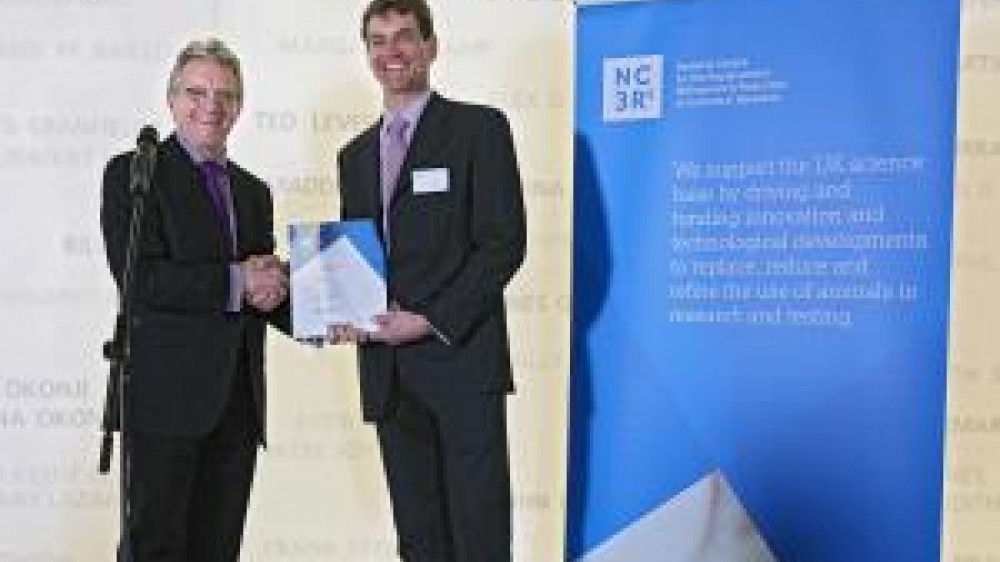Taking inspiration from human orthopaedics to improve research with monkeys

Dr Daniel Adams speaks to the NC3Rs about how he drew on techniques from modern orthopaedics and dentistry to develop the refined recording chamber.
Dr Daniel Adams, from the University of California San Francisco, works with non-human primates on neurophysiological studies. This type of research aims to improve understanding of normal brain function, and how neurological disorders affect brain activity on a single neuron level. Dr Adams recognises that as long as non-human primates are used for this type of research, it’s important to continually strive to find ways to refine the scientific procedures involved in order to improve both the welfare of the animals and the quality of scientific data obtained from them.
Dr Adams has been awarded a highly commended award in this year’s NC3Rs 3Rs Prize competition. He was recognised for developing a new device for recording electrical impulses in the brains of non-human primates – the novel recording chamber is less intrusive, easier to implant, and requires less maintenance and cleaning when compared with older approaches. It is one of the first developments made for several years that significantly refines the methodology for studying neurophysiology in non-human primates.
The standard approach to attaching recording chambers onto the skulls of monkeys used in behavioural neuroscience has changed little since the 1950s. Traditional techniques use acrylic cement, which does not bond well with bone tissue and is prone to harbouring infection. Acrylic-based implants also have a depreciating life span and are obtrusive. In addition to causing discomfort for the animal, their appearance can provoke strong emotional reactions in both researchers and the concerned public.
“When I first started these kinds of experiments, I realised that there had to be a more biocompatible way of implanting devices,” Dr Adams told me, and this is exactly what he has found. His improved method is outlined fully in a paper published in the Journal of Neurophysiology.
The device, which uses modern materials developed for use in human surgery, is made from titanium and sealed to the animal’s skull using hydroxyapatite cement, which is more biocompatible than the acrylic used traditionally. This reduces the occurrence of infection and the associated deterioration of tissues around the device. As a result, maintenance and surgical interventions are minimized, reducing disturbance and discomfort to the animal.
It wasn’t just developing the device that was the challenge for Dr Adams; there was another hurdle to overcome. He talks about how some researchers are wary of deviating from traditional, trusted procedures, saying, “Once a technique is accepted generally and becomes part of the scientific culture it is sometimes very difficult to introduce changes.” Non-human primate studies can be very long and expensive; therefore researchers can sometimes be reluctant to try something new.
However, Dr Adams has tried and tested a series of incremental refinements to develop the new recording chamber. By combining many of these smaller developments, the new device offers the potential to radically change the standard approach. When describing his work, Dr Adams states, “My main contribution was to take all the refinements that other laboratories had made, and to introduce some of my own, and then to publish that work in the hope that it would become adopted by other laboratories because of the significant animal welfare advantages that it proposes.”
Since carrying out his study, Dr Adams has worked with many different institutions to define their current practices and their refinement needs. He hopes that this exchange of information will continue. “In collaboration with the NC3Rs, I’m hoping to encourage much more communication within the community of non-human primate researchers, so that techniques like this and other refinements that are made in laboratories across the world can be shared,” Dr Adams explains.
Listen to the podcast to hear the whole interview with Dr Adams and to find out more about the refined recording chamber.
References
-
Adams, D., Economides, J., Jocson, C., Parker, J., & Horton, J. (2011). A watertight acrylic-free titanium recording chamber for electrophysiology in behaving monkeys Journal of Neurophysiology, 106 (3), 1581-1590 DOI: 10.1152/jn.00405.2011
